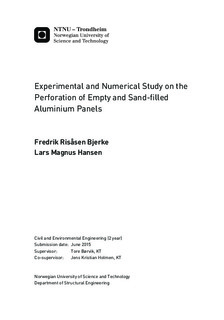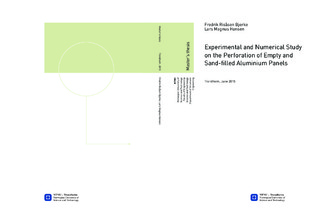| dc.description.abstract | The discrete particle approach has previously proven to give excellent agreement between experiments and numerical analysis for blast and penetration in granular medias. The main objective in this thesis is to further investigate the accuracy of the particle-based approach for penetration in granular materials, and compare the numerical output with conducted experiments. A literature survey on penetration in granular media is also carried out to understand the main mechanisms.
Ballistic limit curves and ballistic limit velocities have been identified by experiments performed at SIMLab, NTNU, on empty and sand-filled AA6005-T6 aluminium panels impacted by 7.62 mm APM2 bullets. Three different fractions of granular media have been tested, with a median grain size of 0.15 mm, 0.55 mm and 0.95 mm. The experiments showed minor differences in ballistic limit velocity between each fraction of sand, but an increase of at least 32.5 % is seen when going from empty to sand-filled panels.
The non-linear explicit finite element software IMPETUS Afea Solver is employed in the numerical work in this thesis. The parameters in the particle model were calibrated through numerical simulations against gas-gun component tests. In addition, drop-tower component tests were carried out, allowing the particle-based method to be validated over multiple velocity domains. The component experiments and numerical simulations are in good agreement for impacts in the high velocity domain. In the numerical simulations for empty and sand-filled panels a standard Johnson-Cook constitutive relation is used for all structural parts, while fracture is modelled with a Johnson-Cook criterion for the aluminium panel and a Cockcroft-Latham criterion for lead tip and brass jacket. The numerical results were finally compared to experimental observations, which showed that IMPETUS Afea Solver is able to capture the main trends in the perforation process.
The influence of various numerical input was also investigated in a rather comprehensive sensitivity study. This showed that the input for the aluminium panel seems reasonable compared to computational cost for the complex model applied in this thesis. | |

